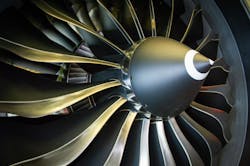The peculiarities of aviation oils are many. They must be able to withstand high temperatures, and they must be compatible with seals, paint, and composite materials. In this feature, we have reached out to industry experts to define best practices on the selection and use of aviation oils.
According to Martyn Horstink of the Amsterdam Engineering Team at Air France Industries KLM Engineering & Maintenance, it is important to concentrate on high performance capability (HPC) oils. “The use of the non-HPC oils will decrease as these oils causes thermals stability issues at higher temperatures which could lead to maintenance burden,” he says. “The HPC oils are favoured for their superior thermal and oxidation stability over a wide range of operating conditions.”
According to David Fojón, president and chief executive officer (CEO) of Avioparts, an important aspect of aviation oils is that they must have improved compatibility with seals, paint and various composite materials. “All the engine-approved oils must be miscible and compatible with one another in all proportions. This is a mandatory test requirement in the equipment manufacturers’ approval procedures,” he says.
Occasionally there is a need to change an engine to a different oil and some precautions should be applied before making a change, explains Fojón. “O-ring elastomer seals in the engine should achieve an acceptable equilibrium between the compression set and the lubricant swelling action. A sudden change to a lubricant with a different formulation can disturb that equilibrium. The slow introduction of the new oil will lessen these effects,” he says.
Oil deposits produced by the previous lubricant can be removed from the formulation site by a different oil, affirms Fojòn. “Due to the very wide range of deposit types encountered, it is not possible to fully predict this effect. It has been noted that the deposit loosening effect is not as prominent if the changeover is made slowly,” he says. “The previous oil should be satisfactory for continued use. For both ecological reasons and for cost-effectiveness, this oil is not typically drained from the system. Change by top-off (mixing) allows the changeover to take place slowly, and there is increasing evidence that this is less of a shock to the engine and engine oil system. So, while most engine manufacturers allow change by top-off (mixing), other engine manufacturers do not and only allow changeover by either drain and refill, or drain, flush and refill.”
There are characteristics to consider when evaluating the impact of an oil. “The amount of carbon deposits formed from oil mist and vapor contact with hot engine surfaces should be considered, and so should be the load-carrying ability, which provides for heavy loads on the bearing systems of turbine engines,” he says. “Cleanliness with minimum formation of sludge deposits during severe operation is also important. In addition, an oil’s resistance to physical or chemical change resulting from oxidation permits long periods of serve operation without significant increase in viscosity or total acidity, the main indicators of oxidation. Finally, seal wear is essential for the life of engines with carbon seals, so there should be the lubricant properties preventing the wear of the carbon at the carbon seal face.”
As to the current high thermal stability (HTS) types of oils on the market, Horstink observes that these are more aggressive to engine seals and O-rings in the long run. “Therefore, the introduction of HTS oil compatible O-rings (like Viton-GLT O-rings) in the engine is highly preferable. This can either be done via field modification or introduced by the OEM in factory new engines. HPC oils have the superior thermal stability and are less aggress to O-rings and seals,” he concludes.
About the Author

Mario Pierobon
Dr. Mario Pierobon provides solutions in the areas of documentation, training and consulting to organizations operating in safety-sensitive industries. He has conducted a doctoral research project investigating aircraft ground handling safety. He may be reached at [email protected].
